This scout report delves into the unique characteristics of Jaden Philogene, Roger Fernandes, and Estêvão Willian.
They each stand out due to their distinctive characteristics and potential to reach the pinnacle of the sport.
Each of these players brings a unique blend of skills and attributes to the pitch, making them exciting prospects for the future.
Through tactical analysis, we can better understand how these young talents might shape the future of football.
By examining their skills, playing styles, and potential, we gain insight into the next generation of wingers poised to impact the global stage significantly.
We want to highlight a few key points before diving into our analysis of each player.
In the following section, we’ve separated the ‘winger’ role into three distinct types, and the two distinct dribbling archetypes to provide clarity and enhance the readability of this report.
3 Types of Wingers In Football
The three different types of winger profiles we’ve decided to focus on are: the “take-on” type, the “runner” type and the “creator” type.
When we perform analysis on wingers, it’s important to note that players can overlap in two different profiles or even all three of these.
Take-on wingers
Take-on wingers are 1v1 specialists.
They love to take either man on 1v1 and get past them in a duel.
They occasionally like to invite a second opponent to come in and try to double-team them.
The goal is to beat their man and progress the ball into the penalty box as quickly as possible.
These are wingers like Jérémy Doku, Rafael Leão, Sadio Mané, or Adama Traoré.
Runner Wingers
Runner wingers love to enjoy and manipulate the space in front of them.
They can easily make runs behind defences and are great at being ball carriers in transition.
These types of forwards can work shifts as CFs if necessary or play as inside forwards.
These are wingers like Raheem Sterling, Heung-min Son, Rodrygo, or Marcus Rashford.
Creator Wingers
These types of wingers usually possess more intelligence.
They are the wingers that can dictate matches on their own.
Whether in wide zones or inverting into central spaces, they use good final ball delivery and intelligence to push their team forward.
These are players like Lionel Messi, Neymar, Eden Hazards, and Mohamed Salah.
Some smaller names for this profile can be Bukayo Saka, Leroy Sané, or Lamine Yamal.
Of course, these profiles can overlap.
For example, players like Lionel Messi, Neymar, Mohamed Salah, and Eden Hazard are creator wingers but also take-on wingers and possibly runner wingers, depending on the scenario.
Creator wingers are those that have elite attributes and many characteristics compared to the rest of the wingers in the football world.
2 Types Of Winger Dribble Archetypes
Stop-Motion Dribbling
Unlike traditional dribbling, stop-motion engages the duel by waiting for the opponent, turning it into a battle of timing, posturing, and ingenuity.
This requires precise thinking and preparation, allowing the winger to act decisively when the opportunity arises.
The critical difference lies in his patience.
He waits for the environment to react to him before making his move.
Stop-motion dribbling involves waiting for the ball and the opponent to make the first move; it allows the player to manipulate defenders and exploit openings.
It’s like a calculator; you can’t get to the answer you’re looking for with just one motion, just by typing one button.
You have to type each button, and based on what you type, the following arithmetic symbol of what you want to do with that number until you reach your final answer.
Calculated moves are based on your environment.
Dynamic Motion Dribbling
Dynamic motion is a battle of instincts and speed, requiring a subconscious response and agile movements.
It involves feeling your way through situations and reacting instantly to changes, making it ideal for carrying the ball quickly and efficiently, usually through the middle of the field or sometimes in the wide zones.
Unlike other dribbling styles, dynamic motion avoids duels by moving faster than the opposition because it moves faster than the opponent’s challenge.
The key difference lies in forcing the environment to react to the player’s movements, allowing for swift and fluid progression.
Dynamic motion is like driving a race car.
You rely on intuition and quick reflexes to make split-second decisions, manoeuvring with precision and speed.
Just as a driver reacts to the changing conditions of the race, dynamic motion involves feeling your way through the field and staying ahead by moving faster and more efficiently.
Estêvão Willian Scouting Report
Estêvão Willian is your creator winger.
He is a player who can receive the ball anywhere on the pitch, take on players 1v1, run in behind the defence, break defensive structures, or be a creative outlet—a generational talent with elite ball-striking abilities.
When carrying the ball, Estêvão demonstrates vast stride variance.
He is able to change his direction of run and use his body to manipulate defenders into taking wrong steps in 1v1 duels with shoulder drops, ultimately beating them as a 1v1 specialist as well (take-on winger).
He has the potential to run games on his own in the future.
Estêvão Willian Stop-Motion Dribbling
Estêvão Willian excels at taking players on 1v1 due to his unique stop-motion dribbling.
Below is a perfect example of his take-on ability and sense of intelligence.
In the first image, he patiently waits for the opponent to make the first step.
They are both in a neutral 1v1; nobody has the advantage in this situation.
In the second image, Estêvão dribbles to his left and his opponent’s right.
This is because once the opponent planted his feet flat on the floor and pointed his knees away from his body, Estêvão took the opportunity to go in the other direction with his dribble.
He creates an isolation 1v1 scenario with the defender and then uses stop-motion dribbling.
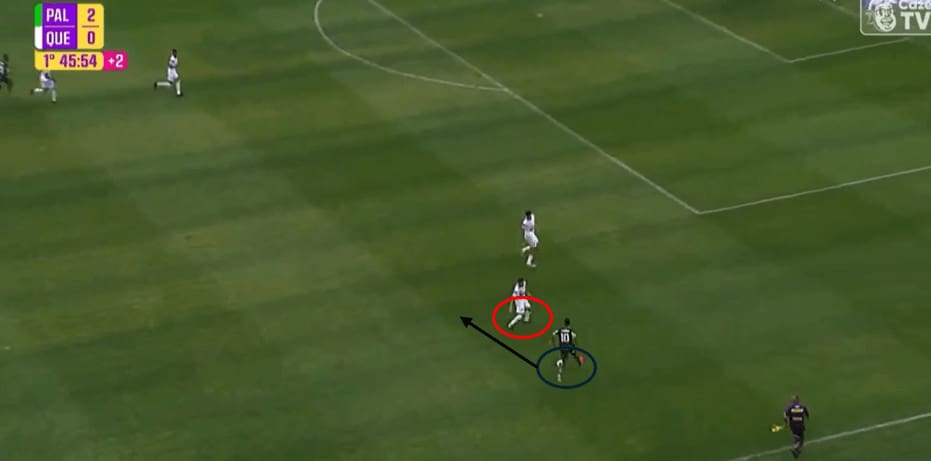
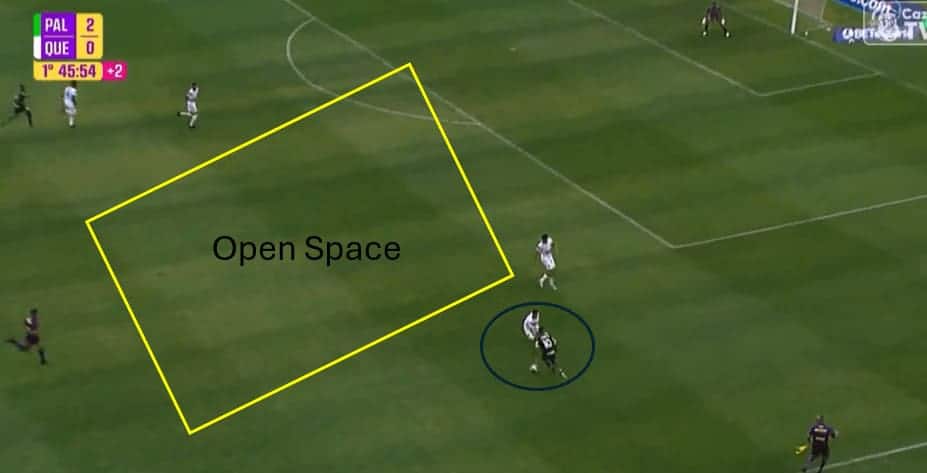
Estêvão Willian Winger Actions
Below, we can see his winger actions during 2022.
Notice the intensity part of the graphic first.
There is intensity even at the right wing-back position and often centrally, where he can also play as a creative outlet.
However, most of his intensity and winger actions are from the right winger side of the pitch, where he thrives the most.
Estêvão averages 3.04 successful take-ons per 90, which ranks him in the top 94th percentile and 5.46 touches in the opponent’s penalty box, putting him in the top 88th percentile.
This tells us how direct he is, with the goal of getting in the opponent’s box to get a shot off.
He ranks in the 96th percentile for total shots per 90 with 3.58.
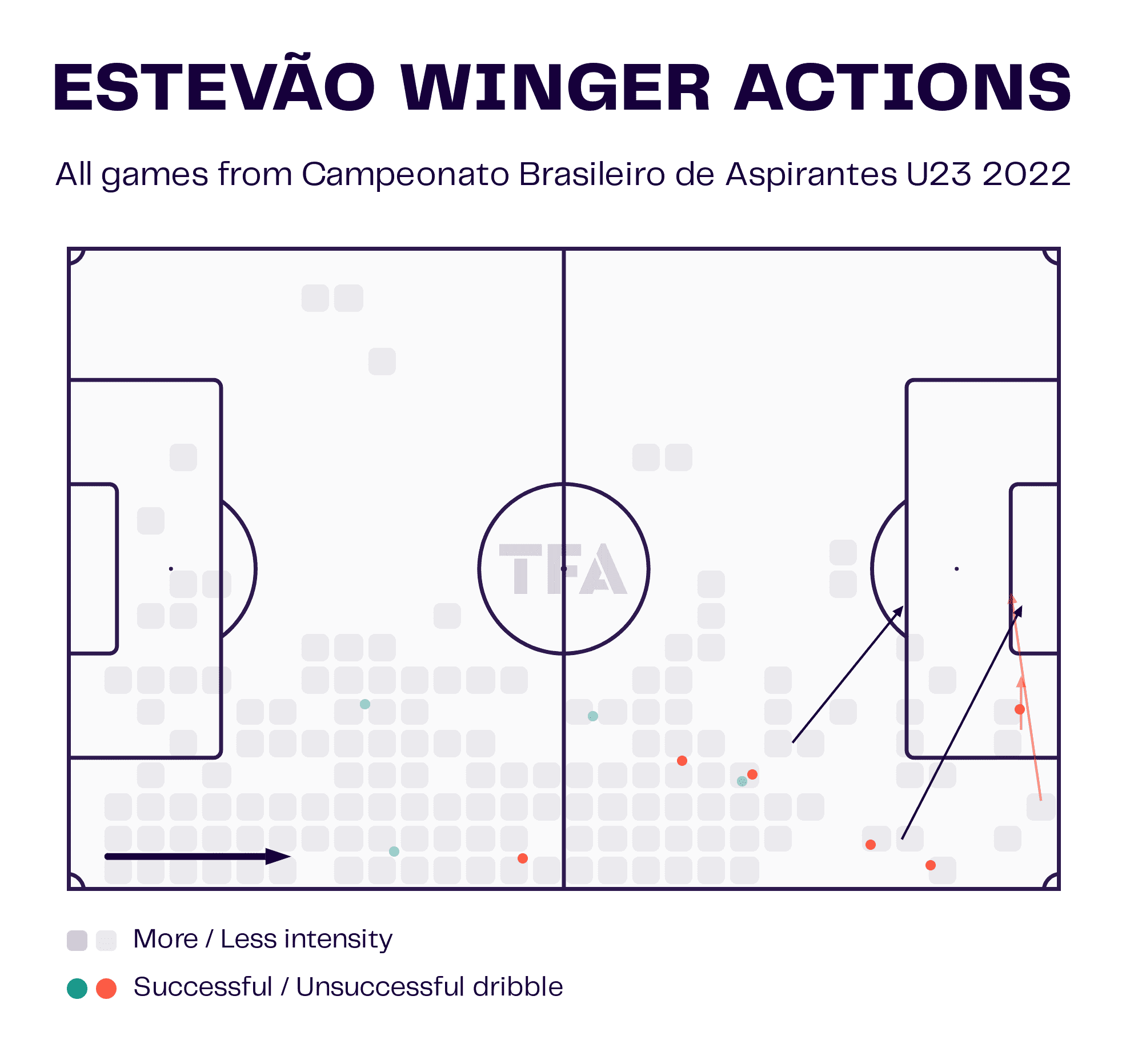
Estêvão Willian Touch Map
Estêvão’s touch map is extraordinary.
He loves to engage with the opponent in the right central zones of the pitch.
Once that opponent is beaten, there is more space until the second or third line of defence has to step up.
He loves to take players down the right flank rather than dribbling into central zones.
Estêvão can take an inverted role, but he thrives the most in the wide areas of the pitch.
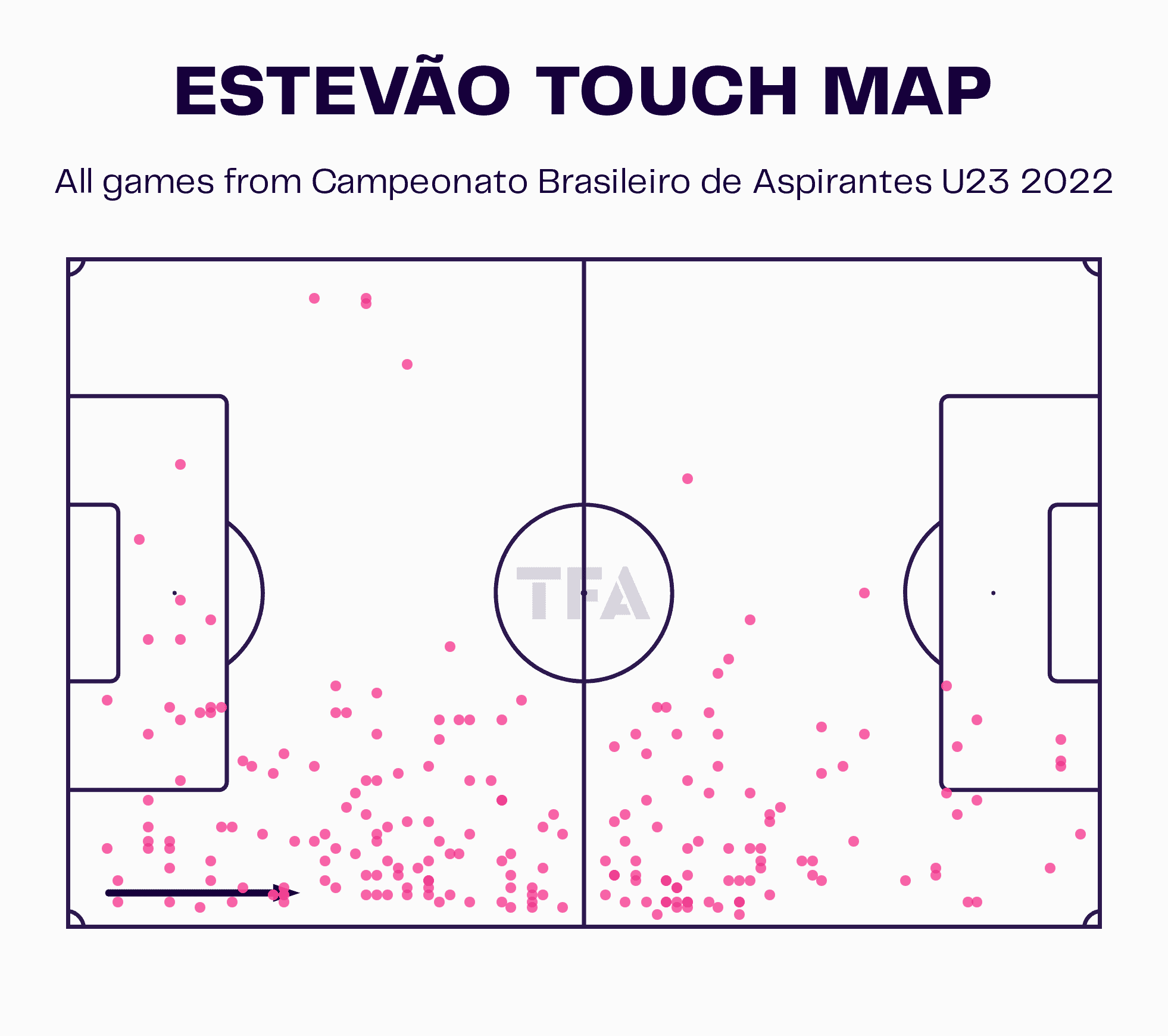
Estêvão Willian Body Manipulation
Another impressive trait is his ability to change his body direction in milliseconds, which is why he is so effective at ball striking.
He can shift his body perfectly to strike the ball cleanly.
In the first image below, notice that if he were to take this strike in this position, the shot outcome would likely be poor.
We’ve seen it often in football with wingers or strikers taking awful shots due to their body positioning.
However, notice in the second image just how well his body is facing the net to let off a perfect top-corner goal strike, all while the defender cannot track him down.
Usually, when it takes a player to shift their body correctly to let off the perfect strike, the opponent can clear the ball, intercept it, put in a tackle, or take some defensive action to disrupt the attacker’s shot.
In this example, Estêvão shifts his body so quickly that the opponent still cannot close him down in time.
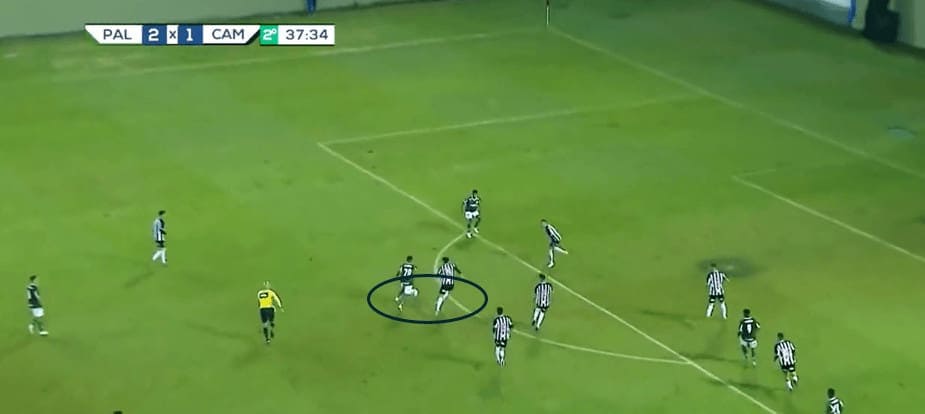
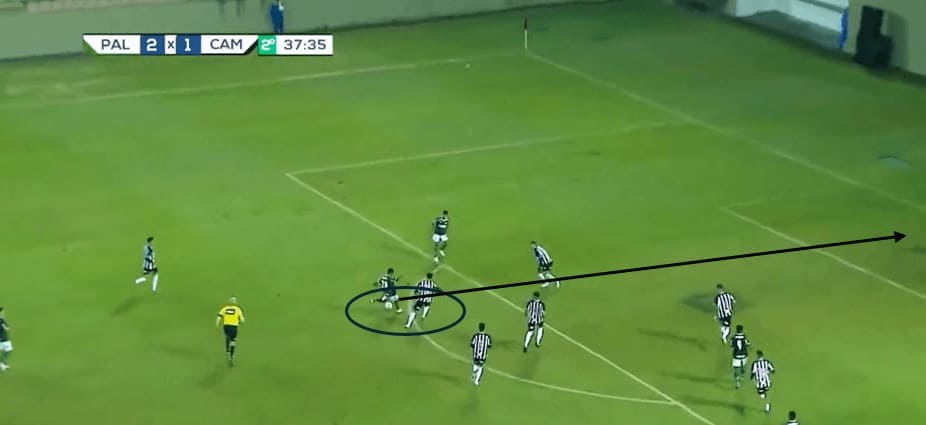
Estêvão Willian Creativity
When looking at the final aspect of his creativity package, there’s more to it than just the final pass product; we don’t want to look at just how much he passes into the penalty box, cross rate, or other types of passes.
Being a part of the creator winger profile is more than that; it’s where you can receive the ball and progress the team forward.
Estêvão Willian Progressive Pass Map
It’s easy to analyse his progressive pass map.
It’s impressive to see a young player always looking to move forward intelligently.
Football isn’t just about moving forward; it also involves side-to-side progression.
However, Estêvão has both.
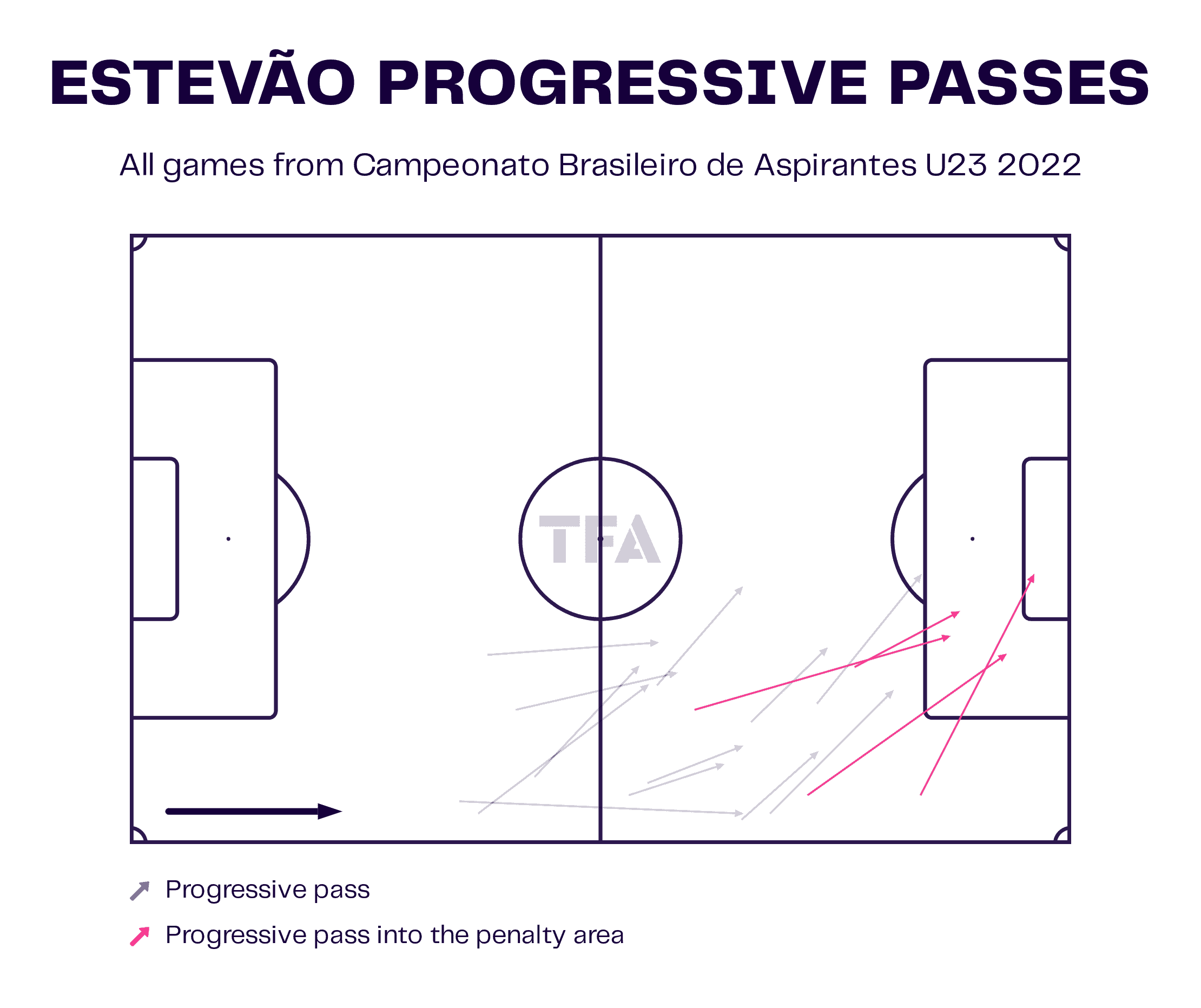
Estêvão Willian Vs Neymar - Player Comparison
A player comparison would be to someone like Neymar—a creative outlet with flair, 1v1 duelling skills, great ball striking, and micro-body movements to manipulate opponents and take space.
Although Estêvão isn’t as creative as Neymar in his prime, he is still young and able to develop into any type of player.
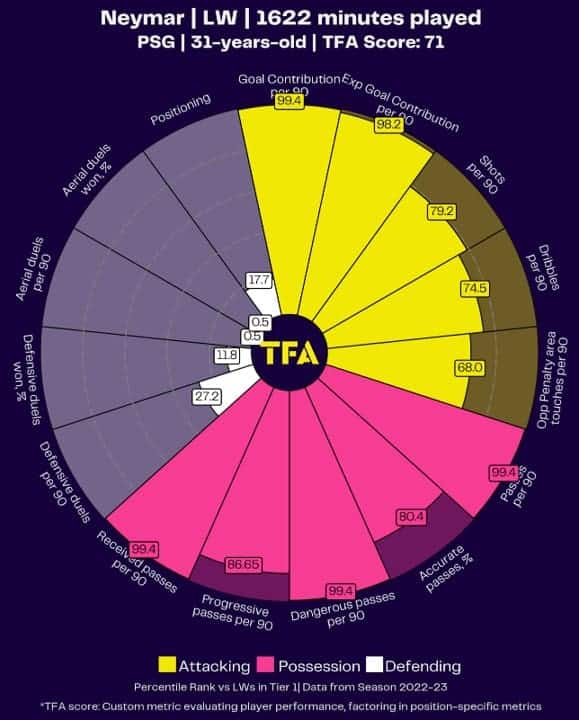
Jaden Philogene Scouting Report
His winger profile makes Jaden Philogene unique; he overlaps between the take-on winger and the runner winger.
A 2 footed winger that loves to play with his opponent, a 1v1 duelist and chaos causer.
Below is the player radar chart, showing he ranks very highly in key winger attributes: 96th percentile for shots per 90, 93rd percentile for dribbles per 90, and 84th percentile for touches in the opponent’s penalty box.
He ranks lower in the passing categories, such as the 65th percentile for progressive passes, 44th percentile for dangerous passes, 60th percentile for accurate pass rate, and 53rd percentile for overall passes per 90.
Why is that?
It's because he’s not part of the creative winger profile.
His goal and idea are to beat his man 1v1, and sometimes invite the 1v2 duel, beat the player, and get into the box where chaos erupts.
His physical build and profile also allow him to be a runner profile.
That’s what makes him unique—the overlap.
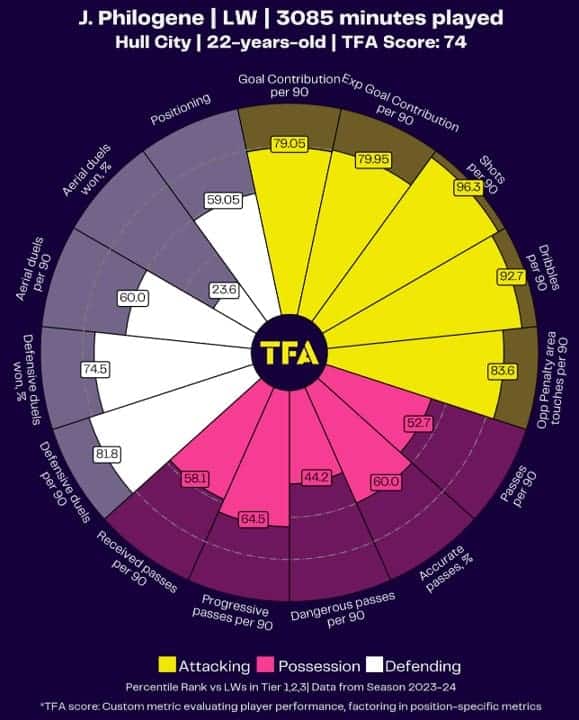
Jaden Philogene Stop-Motion Dribbling
Look at the three images below, a perfect representation of his 1v1 take-on profile.
The play settles, and the ball is stopped, but his goal is to reach the penalty box or, if possible, put in a cross.
With his sheer speed and quick use of acceleration, he puts the ball past his opponent and goes for a run.
These types of wingers create chaos on the wing and bring excitement as well, with the confidence and ability to put on a show and take their opponents for a run.
The play is settled, and he looks at his environment to determine his next move.
The opponent’s body positioning is unfavourable.
Philogene sees this and takes his chance.
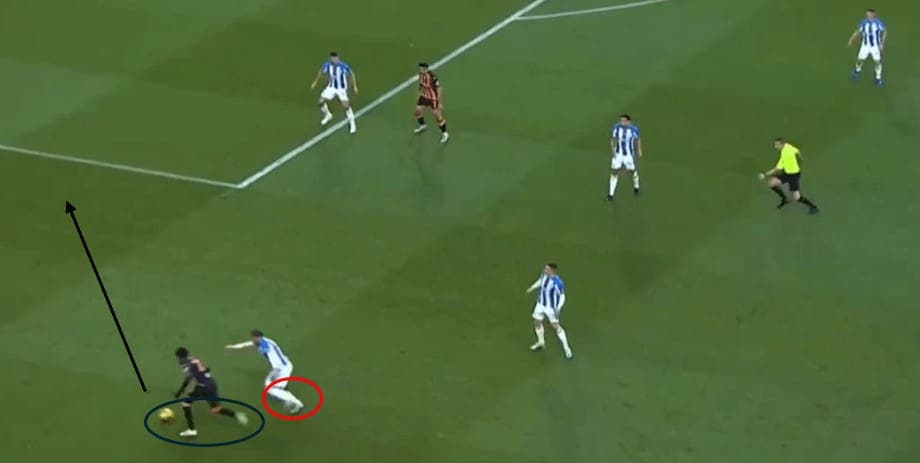
With his use of acceleration and physical profile, the opponent can’t catch him.
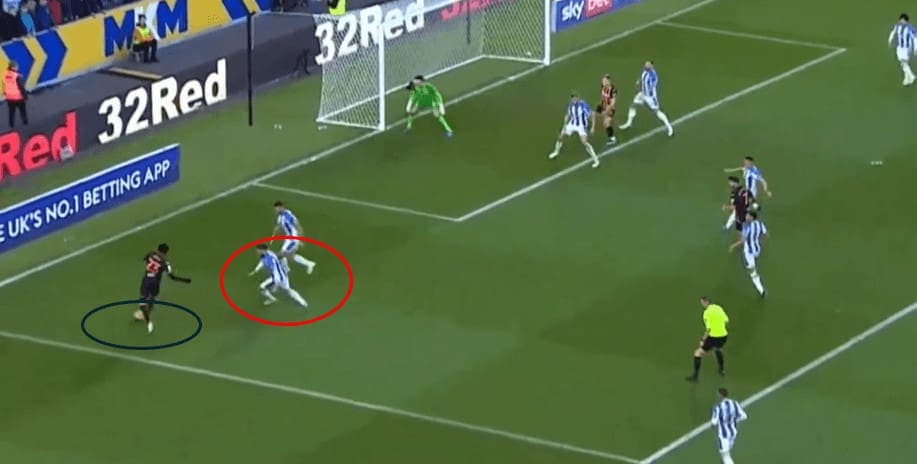
He ends up in the penalty box from that action, where he was hoping to end up.
From here, it is completely up to the winger to make the following decisions in the penalty box.
Philogene is also a stop-motion dribbler.
He calculates his next move based on the environment and the opponent’s actions.
He takes off once the opponent plants his feet fully on the floor.
He waits for this opportunity to arise.
Notice in the first image that his right heel is not on the floor; he’s ready for take-off.
Jaden Philogene Take-On Profile
Remember what I said about igniting the 1v2 duel for these take-on winger profiles?
The image below is a perfect example.
If this situation were a 1v1 duel, Philogene would take on the opponent, head wide, and then try to enter the penalty box.
Since the opponent’s midfielder came to support the full-back, Philogene takes this chance to show his flair and use of acceleration.
Using stop-motion dribbling, he reacts to his environment and beats both players into a central zone since more space is available due to the overload that was caused.
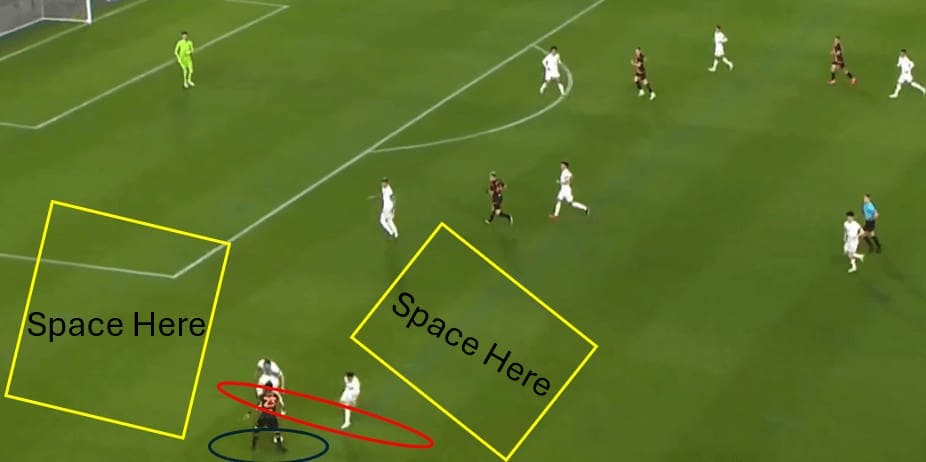
He notices the 1v2 duel, with space behind and to the left; his goal is to reach the penalty box.
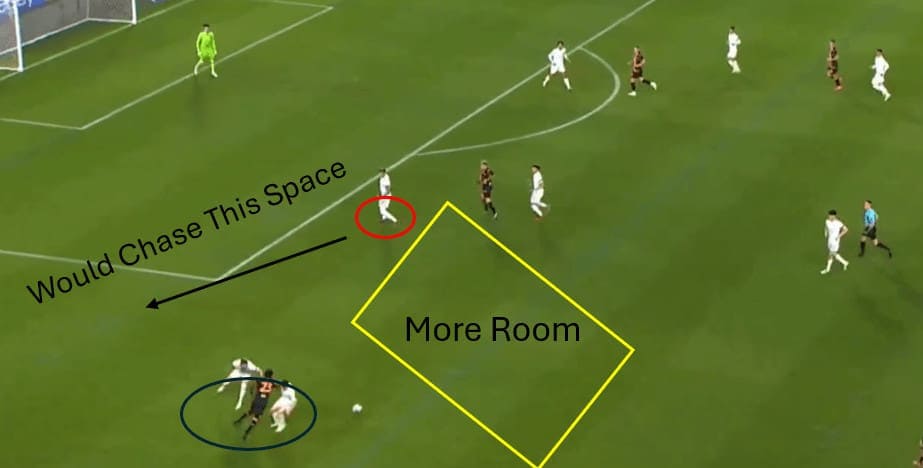
He beats both players’ space to dribble into the box from the central zone.
Jaden Philogene Winger Actions
Below is the graphic of the winger actions for Jaden Philogene.
He is primarily a left winger but can also shift to the right, as evidenced by his dribbles, intensity, and crosses from the right.
However, his best output is from the left.
What else can we see from this graphic?
His ability to cut inside and take a central zone once around the penalty box.
This is a strength of his game; many wingers are great on the wings but freeze when it comes to the box and entering the pitch centrally.
The cluster of players puts too much pressure on them but not on Philogene.
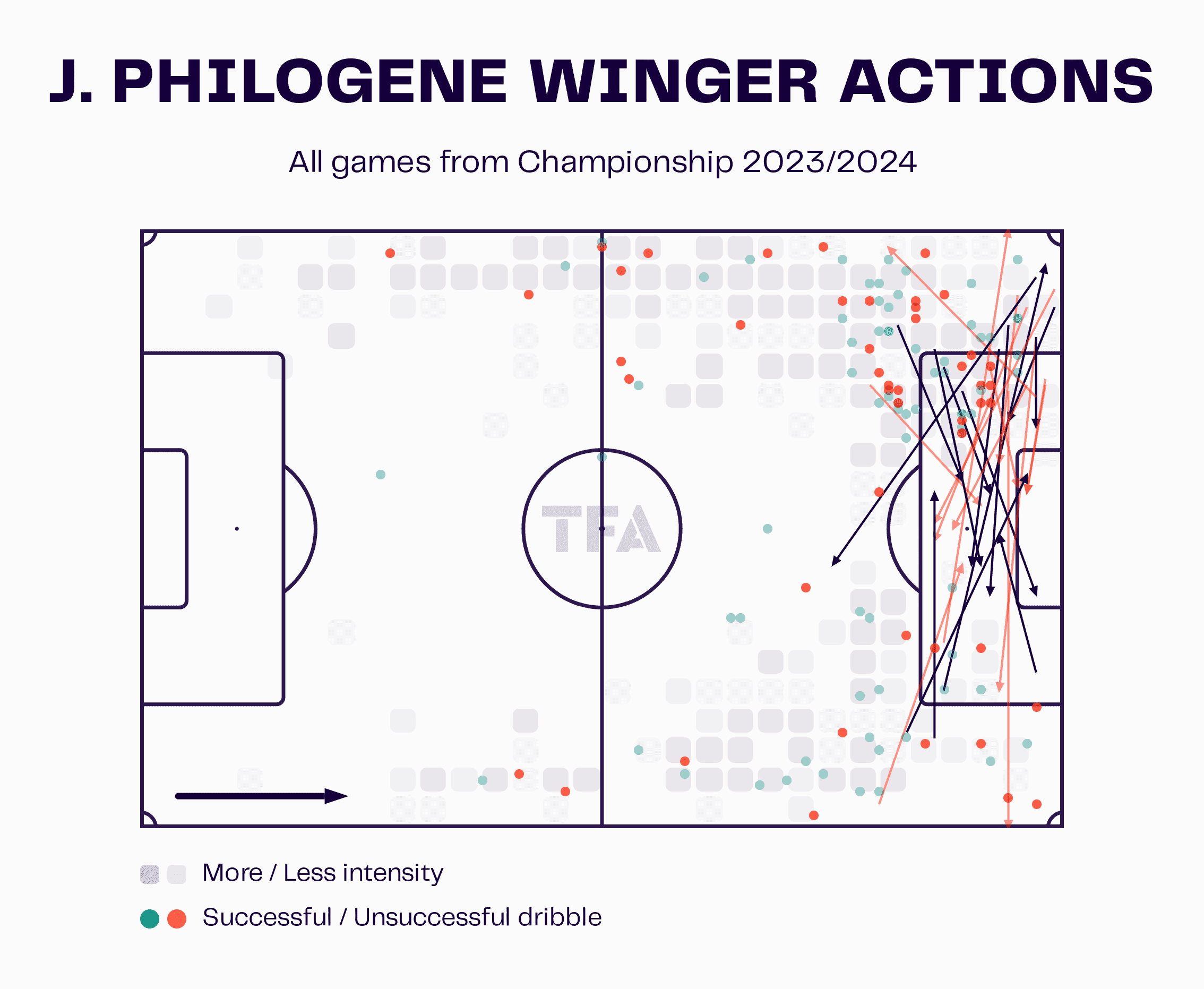
Jaden Philogene Ball Progression
The ball progression graphic below shows his runner profile.
He can make progressive runs in behind with the ball at his feet and without possession.
He can carry the ball from more midfield zones and progress it forward with a 1v1 take-on mindset.
This is where we see the overlap of his two winger-type profiles.
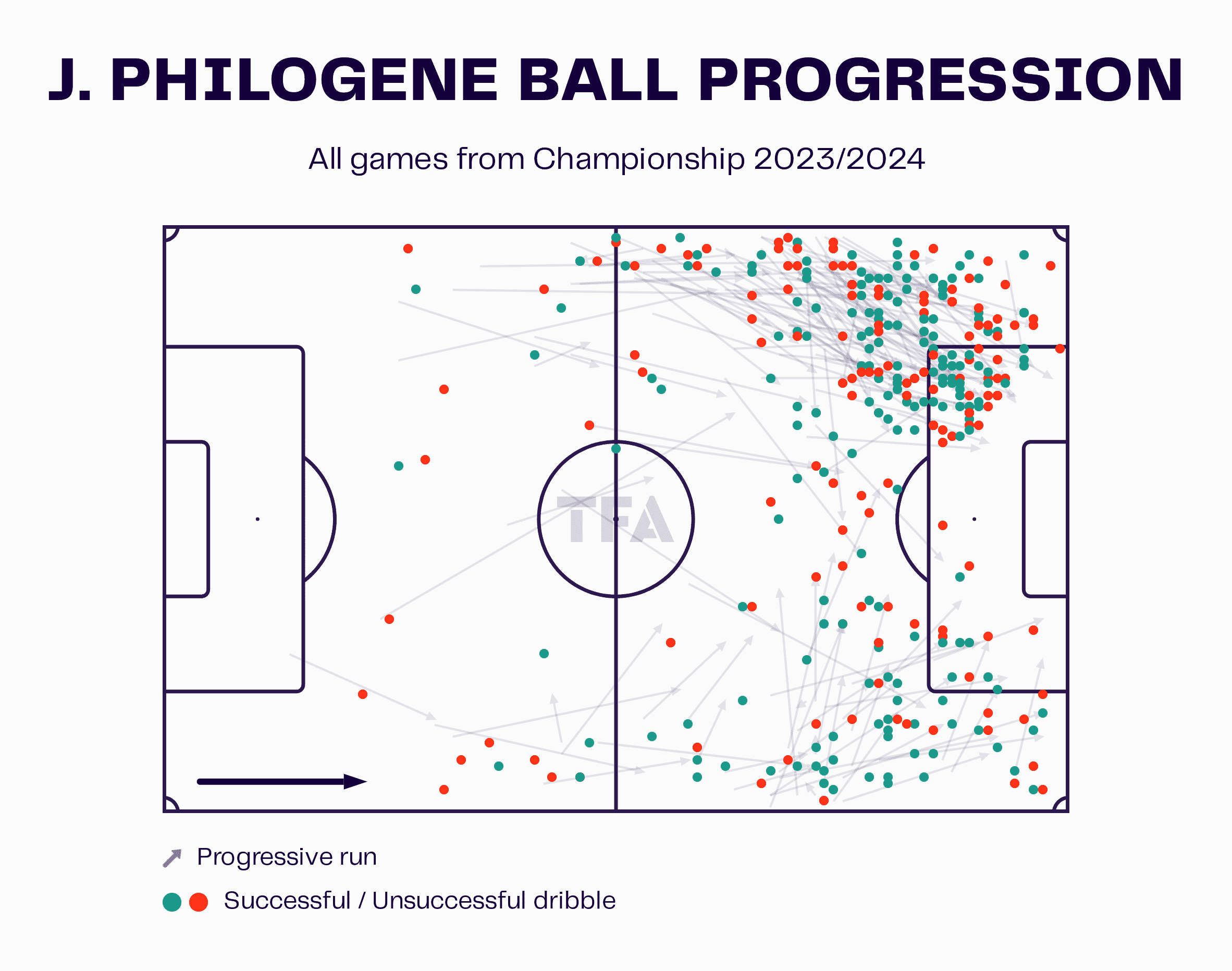
Jaden Philogene Vs Rafael Leão - Player Comparison
Jaden Philogene comes from the same archetype of wingers as Rafael Leão, characterised by their physical frames built for attacking space and technical traits that allow them to excel in tight areas.
Philogene can create his own magic moments, working off the touchline and in half-spaces.
He is instinctive close to goal and a valuable asset away from it, embodying the qualities of a versatile two-way winger.
These types of wingers are very dangerous off the counterattack.
From the radar chart, we see that they both excel in similar goal contribution and dribbling aspects, but Philogene, with more defensive duties, ranks higher in those aspects.
Given Rafael Leão’s experience in the top flight, it makes sense to rank his passing aspects higher.
Overall, Leão is undoubtedly better than Philogene, but there are many similarities in their play and thinking about the game.
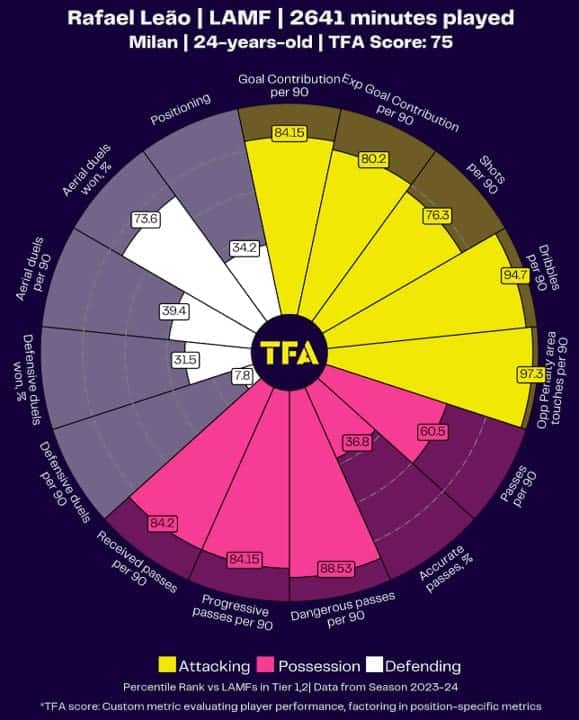
Overall, Jaden Philogene is a 1v1 take-on specialist who aims to enter the box.
He plays with a stop-motion idea, calculating every move.
He is an elite ball carrier and can cause chaos when entering the penalty box.
What else makes him unique is his physical profile, similar to Rafael Leão’s, and his ability to navigate on the pitch.
A recent signing to Aston Villa can surely take his game to the next level.
Jaden Philogene was a standout performer for Hull City during the 2023/24 Championship season.
He led the team in several key areas, including the most touches in the opponent’s box, the most shots, and the most take-ons completed.
His defensive contributions were also significant, with the most tackles and fouls won.
Offensively, Philogene created the most chances, had the most shots on target, scored the most goals, and provided the most assists, making him an invaluable asset to the team.
Roger Fernandes Scouting Report
Roger Fernandes is an electric, pacy winger known for his fearless and confident play.
As an explosive 1v1 specialist, he can excel on both flanks, showcasing top-tier pace and agility.
Fernandes loves looking for spaces behind to play passes or cause chaos with crosses, which he executes exceptionally well with both feet.
His vision is outstanding for his age, allowing him to set the ball up smoothly and look for options before delivering a precise cross.
Fernandes overlaps the runner and take-on profiles but also has some sparks in the creative profile.
He loves to try to set up assists and put himself in positions to whip in crosses but doesn’t fully match the creative winger profile compared to those we mentioned earlier.
Although primarily a winger, he can excel as a second striker or a number 10 in certain instances.
It wouldn’t be a surprise if he took on the midfielder role one day.
He is a player with great positioning, dribbling ability, and can play progressive passes.
Since he is so young and hasn’t played an extraordinary amount of minutes, it’s perfectly reasonable to see his goal contribution aspects in the radar not ranked that high in percentiles when compared to other wingers.
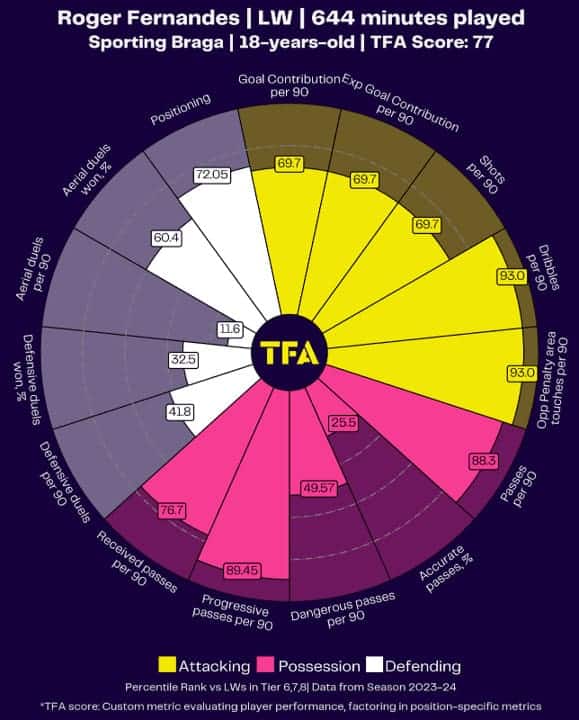
Roger Fernandes Winger Actions
Even with limited playtime, he has great numbers when it comes to winger actions.
We can see high intensity on the right wing, with lots of crosses and dribble attempts.
His love for whipping crosses makes Fernandes unique as a passing outlet.
He averages six crosses per 90 in the 23/24 season and 5.20 shot-creating actions per 90.
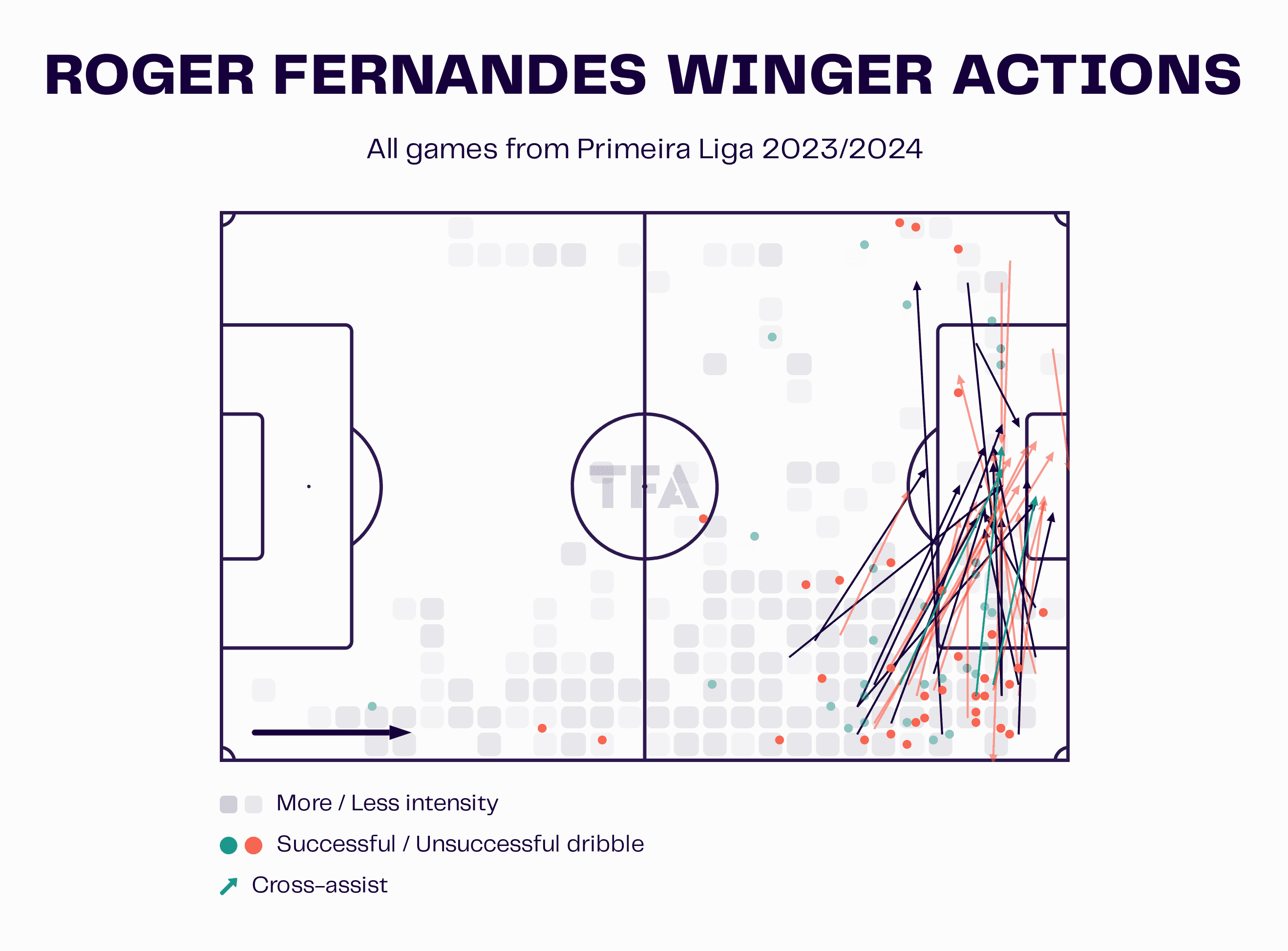
Roger Fernandes Crossing Zones
Looking at his creative outlet style, a roughly 56% completion rate in crosses is not bad at all.
Of course, the majority of the crosses will come from the right, given he is primarily on that side.
It’s interesting to note where these crosses come from.
There is high intensity in a right centre midfield position, which means he attempts long crosses from afar, but also some intensity further down the right, where he will occasionally send a cross after beating his man or choosing to send a cross instead of taking on his man.
His off-the-ball movement puts him in settings where he can successfully take his time to whip in a cross.
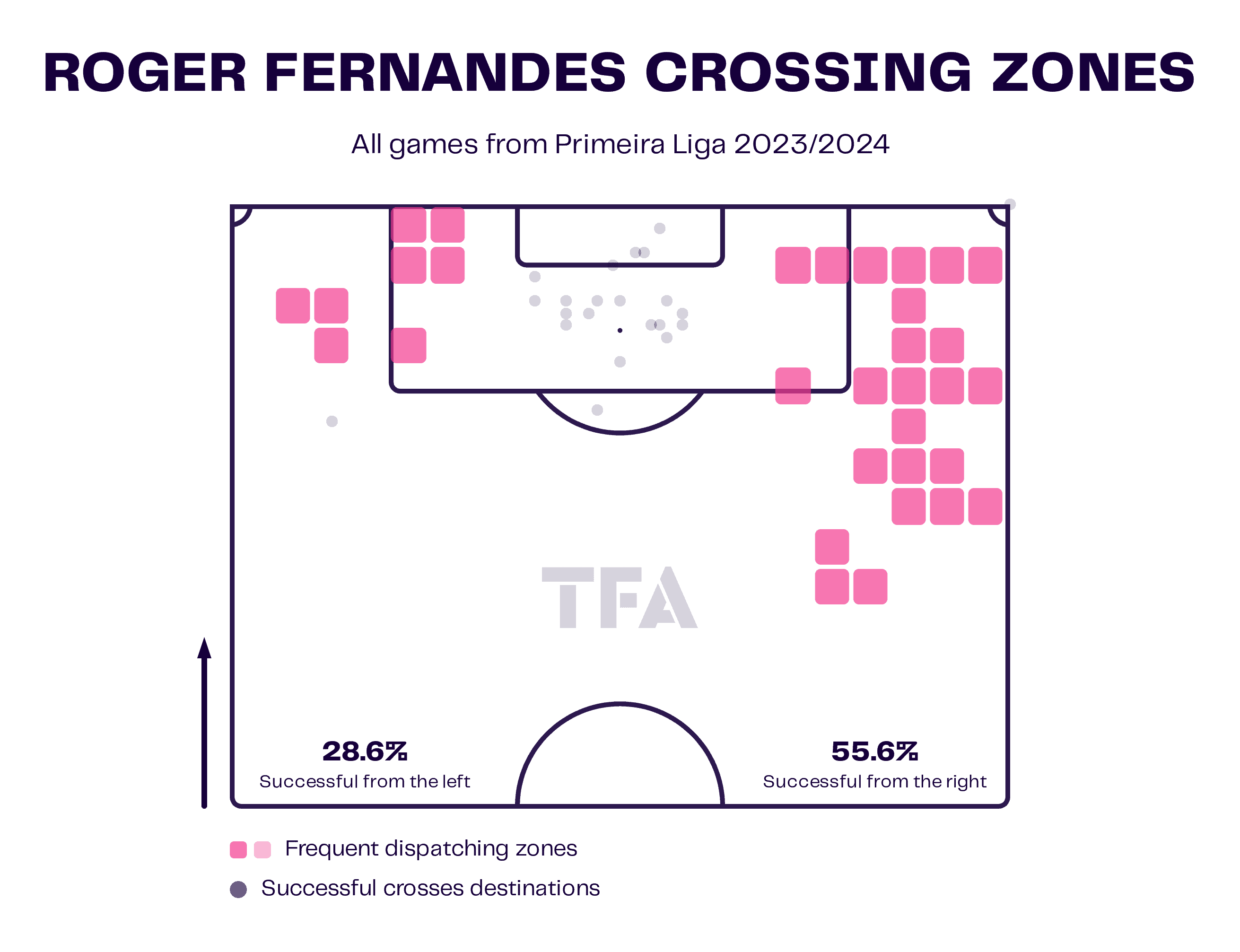
In the images below, we can see instances of how his mind thinks about these crosses.
He thinks of crossing the ball before it even reaches his feet.
We know this because his first touch is a roll forward to set himself up, which first shows his read of the game, knowing a cross is a great option here, given the number of teammates attacking the penalty box.
The second image shows where the cross landed, right in the middle of the box.
Often, we see terrible crosses, which every player makes, but this one was inch-perfect.
The majority of the time in football, crosses aren’t touched by a teammate on the other end.
Still, Fernandes’ crosses are evident in the graphic above and in his composure and calmness when getting ready to deliver these.
Part of this can be due to his team’s tactics.
SC Braga is a club that plays a style of football that welcomes crosses, a perfect fit for Fernandes.
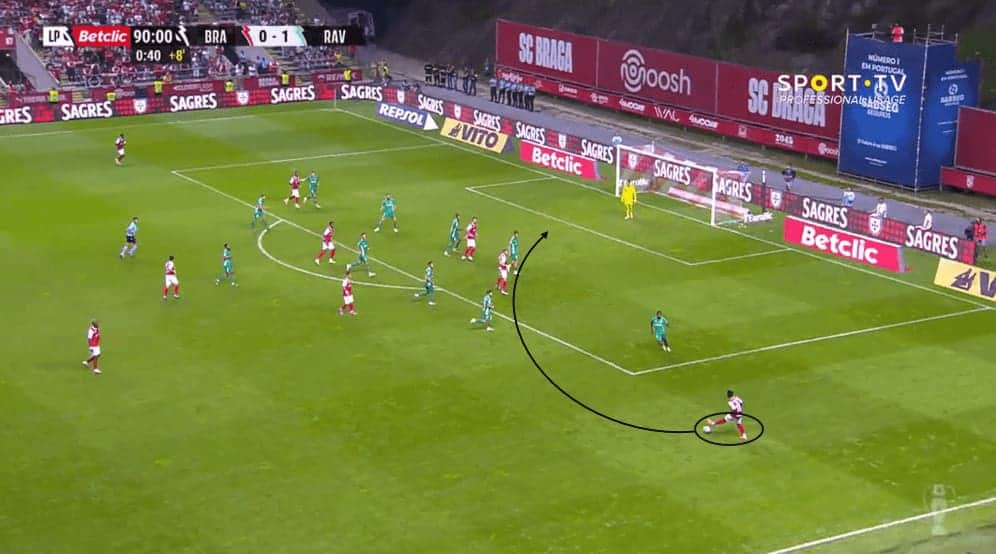
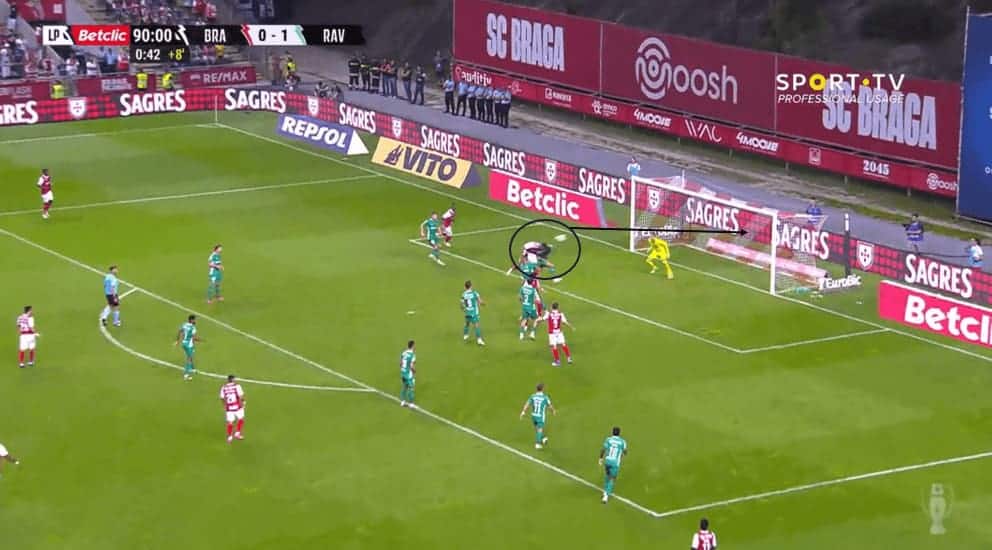
What’s even more mind-blowingly impressive is that he sent another cross just minutes later into the same area of the penalty box, where his teammate got on the end of it.
Roger Fernandes was behind a 90th-minute comeback, turning a 1-0 deficit into a 2-1 victory.
He provided both assists.
Below is a step-by-step breakdown of the second assist, showcasing the great strength in his crosses.
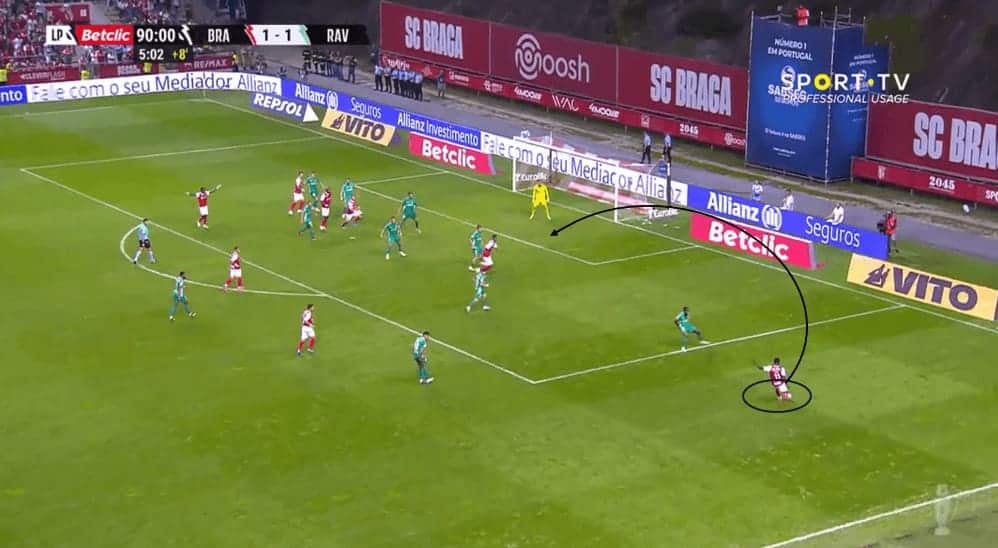
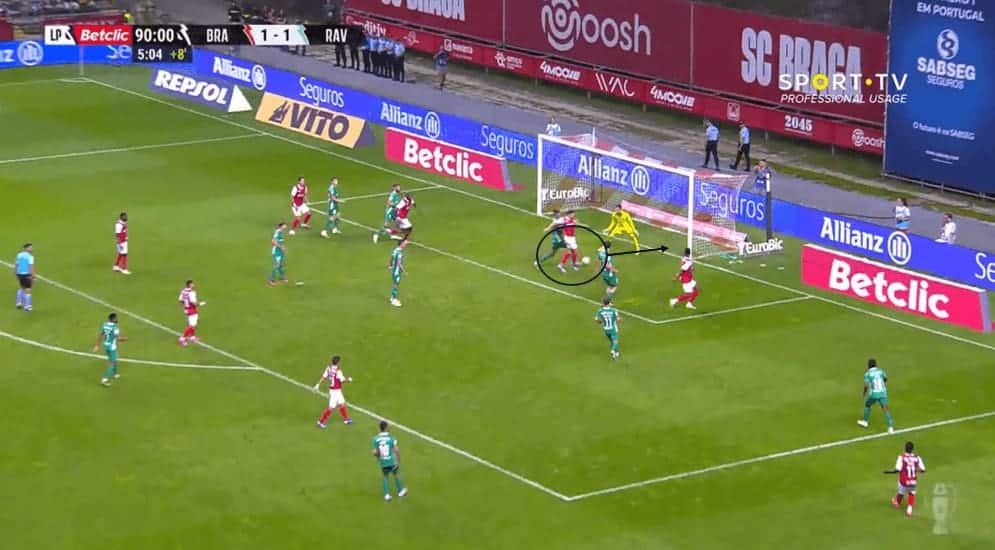
Roger Fernandes Dynamic Dribbling
What else makes Roger Fernandes so unique?
His dribbling style.
We went over stop-motion dribbling before, but Fernandes is a dynamic motion dribbler, or in other words, a fluid dribbler.
A player who moves on instinct and makes decisions without a second thought moves with the groove and stays ahead of his opponent.
His opponent stands there and tries to guess what Fernandes is thinking, but in Fernandes’ head, he’s already at the end destination of his vision.
Below is his ball progression map.
Before I show match footage scenarios, you can see his many attempts to create and make progressive runs with the ball into wide spaces.
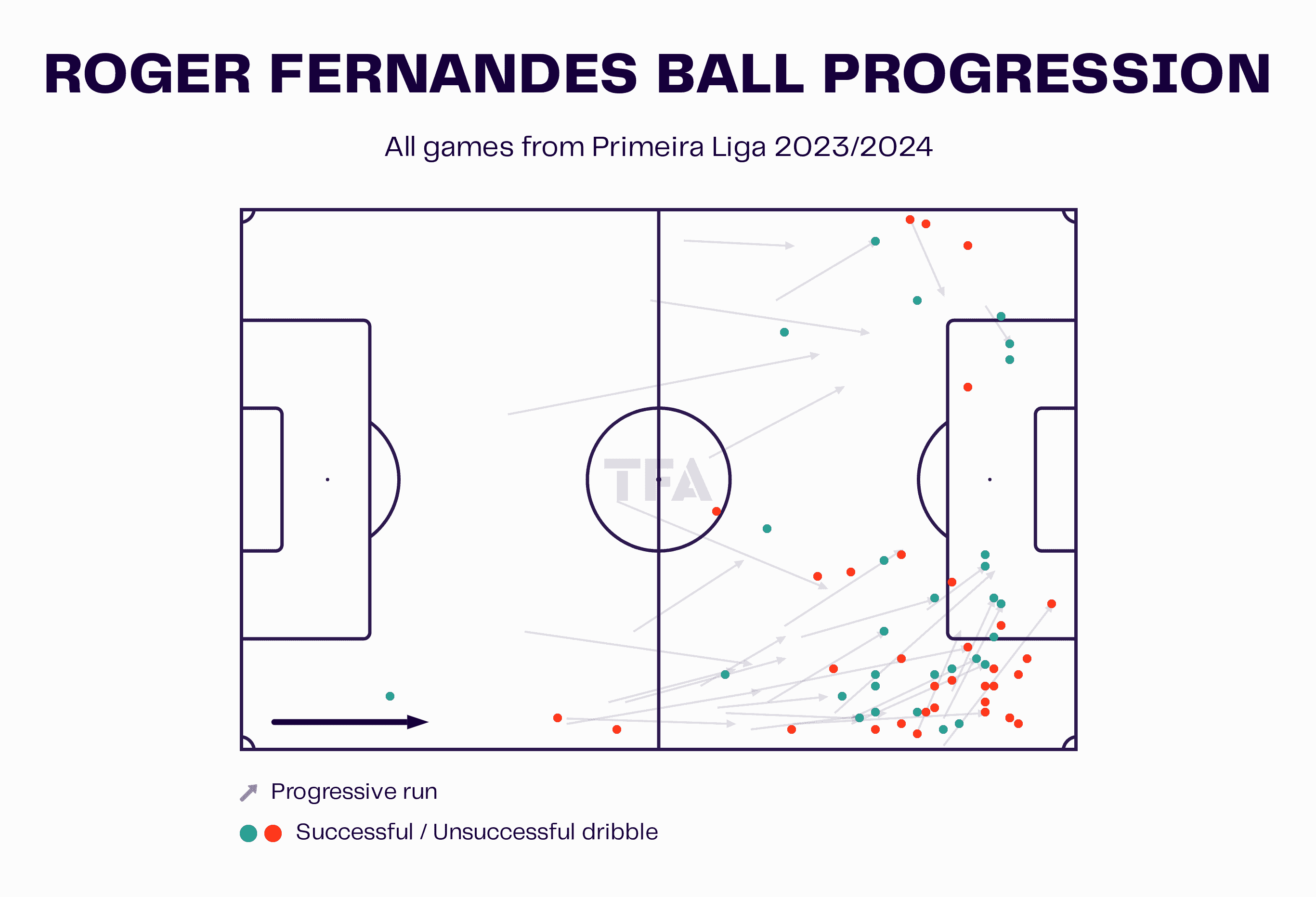
Below is a perfect example of this dynamic dribbling.
He doesn’t look to engage in the 1v1 duel; his body is positioned to put the ball wide and run to it.
The opponent tries to create a 1v1 scenario.
The first image shows exactly what’s going through Roger Fernandes’ head—a game of instinct.
His gut tells him to take the stride forward to his left.
The opponent lunges at him with a standing tackle, but Fernandes’ instinct and dynamic motion beat him.
Before the opponent’s leg is even placed down, Fernandes has run by him and continues his movement.
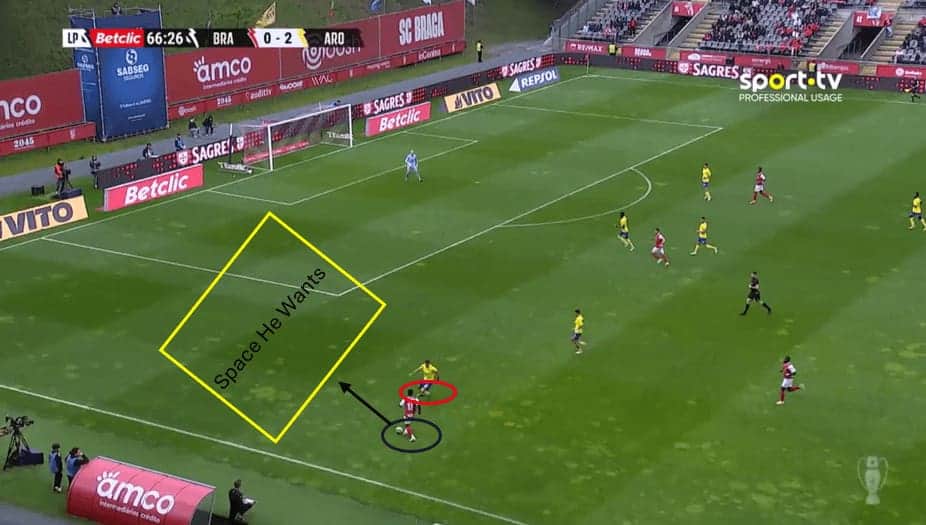
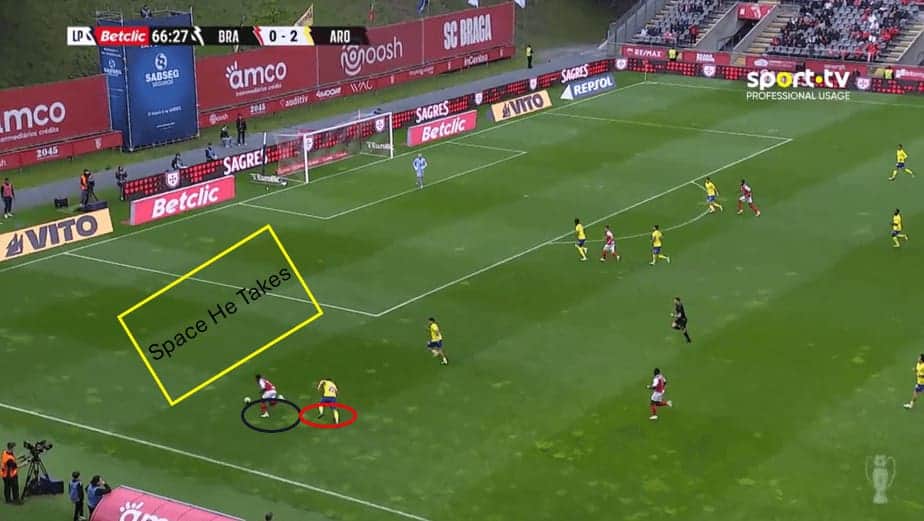
Roger Fernandes is a very interesting player.
He has the characteristics to play in midfield positions, as a second striker, centre forward, or naturally as a winger.
His mind is very creative, and it would come as no surprise if he took on a midfielder role in the future.
He’s unique for his creative thinking, quick pace, and dribbling in tight spaces.
Conclusion
Overall, Estêvão Willian, Jaden Philogene, and Roger Fernandes each bring a unique set of skills and attributes that make them stand out as rising football stars.
Estêvão's stop-motion dribbling showcases his strategic patience and ability to outwit opponents.
His world-class ball-striking abilities are 1 of 1.
With his physical profile and technical skills, Philogene exemplifies the archetype of a 1v1 take-on winger, capable of creating magic near the goal and in wide areas.
Fernandes, an electric and fearless winger, combines top-tier pace and agility with exceptional crossing ability and vision.
Together, these players highlight the diverse talents and exciting potential within the next generation of football wingers.

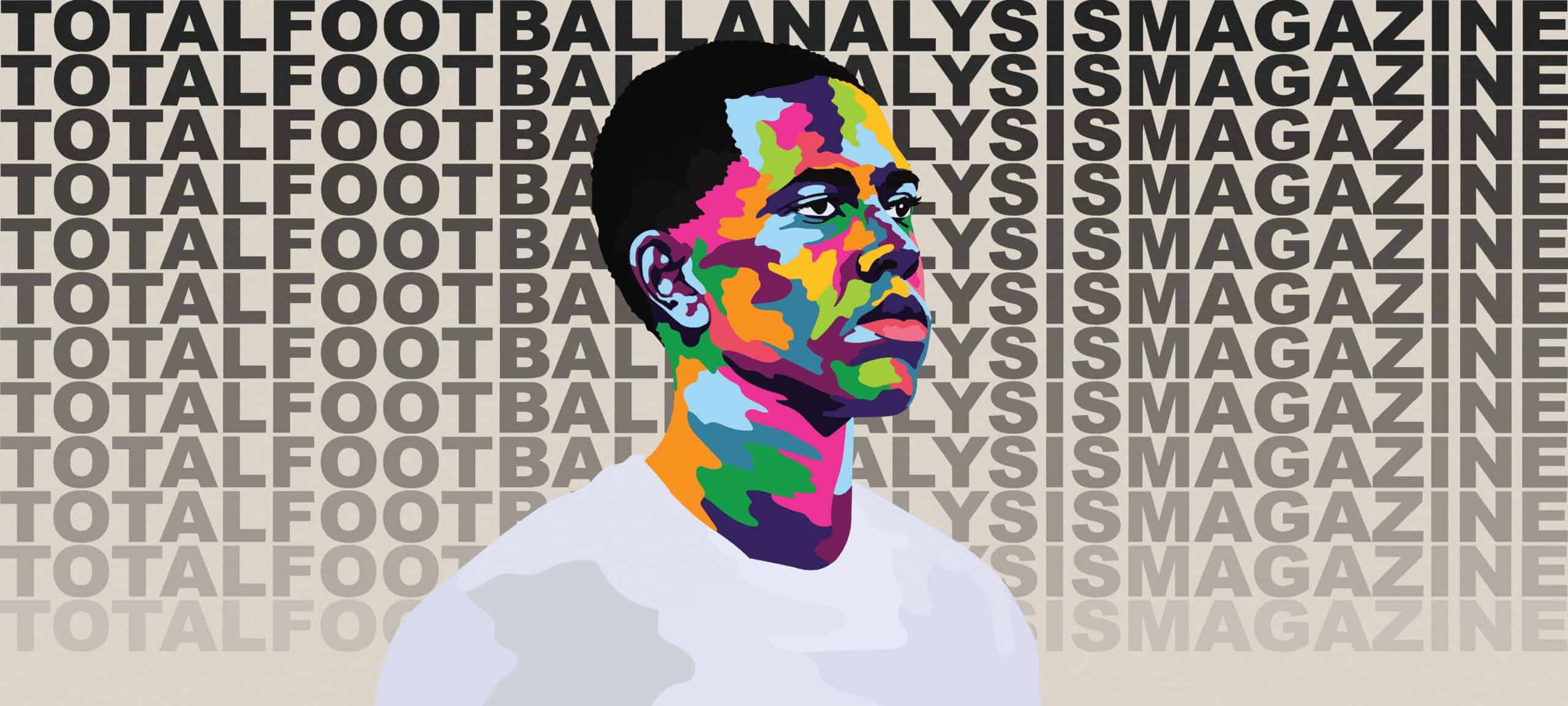



Comments